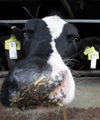Calves clock-in for monitored mealtimes

Electronic ear tags are being used to provide an early warning system that will help farmers identify sick animals within a herd.
The new system, being trialled by scientists at Newcastle University, tracks the feeding behavior of each individual animal, alerting farmers to any change that might indicate the calf is unwell.
Using RFID (radio frequency identification) technology - similar to that used in the Transport for London Oyster card - each calf is ‘clocked’ in and out every time they approach the trough, with the time spent feeding being logged by a computer.
Ollie Szyszka, a PhD student in Newcastle University’s School of Agriculture, Food and Rural Development, who is leading the project with Professor Ilias Kyriazakis, said the aim was to help farmers spot any illness in the herd much earlier on and treat the animals more effectively.
“Just as we know when we are sickening for something because we perhaps lose our appetite or feel more lethargic, animals also demonstrate subtle changes in behaviour when unwell,” explains Ollie.
“Like any animal, the earlier you can spot and start treating an infection or disease the better chance there is of it making a full recovery. You also reduce the risk of the infection spreading if you can identify and isolate a sick animal but for a farmer with a herd of maybe 500 cattle it is easy to miss any early signs of disease.
“By giving each calf a unique code and tracking its feeding pattern our system is able to alert farmers to small - but significant - changes in behavior which might indicate the animal is unwell.”
The project is part of Newcastle University's drive to improve animal welfare on farms and research ways in which agriculture can become more sustainable. Published in the Annual Proceedings of the British Society for Animal Science Conference 2011, the work is being trialled at the University's Cockle Park farm, in Northumberland.
The tracking system - developed by Newcastle University computing technician Steven Hall - uses RFID chips fitted into the ear tag of each animal and short-range antennae mounted to their feeding troughs. The antennae pick up a signal every time the animal approaches to feed. The signal is blocked when the animal moves away.
The animals have also been fitted with pedometers which allow the Newcastle team to measure posture, relaying information about how active the calf is and how much time they spend lying down.
The results so far have shown that cattle suffering from an underlying health ‘challenge’ or infection do show significant changes in their behavior.
Professor Kyriazakis adds: “Modern farming systems have minimised the contact between the animal and its keeper so we need to constantly look for ways to re-address the balance.
“What we are trying to do here at Newcastle is find ways to detect early infection or deterioration of an individual – regardless of the size of the herd – so the farmer can intervene at an early stage.
“In the light of recent outbreaks of diseases such as Foot and Mouth and TB, finding ways of detecting changes in behavior before there are any obvious signs of disease, is becoming increasingly more important.”
Provided by Newcastle University



















